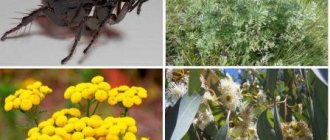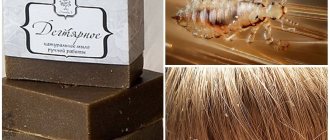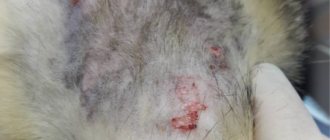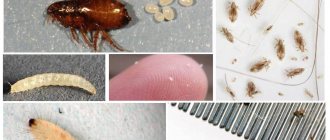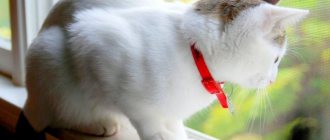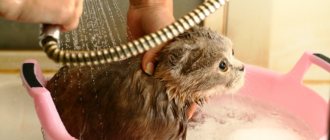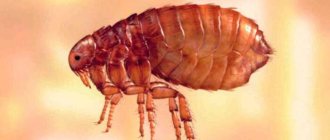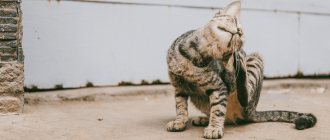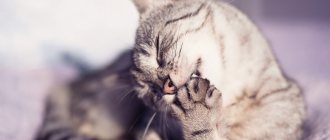Blood-sucking parasites pretty much ruin the lives of pets. Of course, there is a greater chance of catching “uninvited guests” from those cats that walk on the street and come into contact with their yard brothers. Purebred animals are treated for fleas when they are handed over to a new owner. And he must already monitor the condition of the pet’s fur and skin. Not all cats can be treated with insecticidal preparations. They cannot be used to remove fleas from pregnant and lactating cats, kittens, and weakened animals. For this category of pets, tar soap is used. Let's learn in detail about its use in the fight against blood-sucking parasites.
Is it safe?
Tar soap is considered a relatively safe and non-toxic product for cats. Besides, it's cheap. Thus, in comparison with expensive chemicals that act as killers on fleas, tar soap is very advantageous if the cat does not have an individual intolerance to the components.
That is why the use of tar soap is allowed even for kittens 5-7 weeks old, although toxic drops and sprays are prohibited for them.
Unlike many flea products, tar soap does not dry out the skin. However, after it the wool becomes coarse.
Is it effective?
The anti-flea effect in tar soap is achieved through the presence of components with a bad odor that insects simply hate. Birch tar contains benzene, a carcinogen toxic to insects, an antiseptic that also reduces the activity of bacteria and fungi. Phenol and alkali - this pair destroys viruses, bacteria, fungi, parasites. Sodium salts are needed to maintain the water-salt balance of the skin, citric acid repels insects with its smell.
In terms of effectiveness, tar soap has its own drawback: it does not help the first time, because... does not affect flea larvae. That is, adult fleas will most likely die or run away after washing, but the larvae will sit quietly if they are not washed off with water. Therefore, after 3-5 days the procedure will need to be repeated to kill and expel the already hatched fleas. And repetitions must be done until the parasites completely disappear, because they multiply very quickly, as a result of which a few surviving fleas can give birth to huge offspring - and the problem will manifest itself with renewed vigor.
How effective is flea tar?
In its pure form it is a viscous, oily mass. The color is dark, with a greenish-blue tint. Although soap contains up to 10% birch bark tar, it is very effective against fleas, and is also environmentally friendly, safer than any chemicals.
The remaining components included in the soap: about 10-15% phenols, tannins, esters, and acids and alkalis no more than 5%. Thanks to this, soap or shampoo have the following properties:
- antiparasitic;
- healing;
- antiseptic;
- drying;
- reducing (reductive in chemical reactions);
- antimicrobial.
All this makes it possible to use soap not only for animals, but also for people with pediculosis (lice), for the treatment of pustular skin problems, inflammatory processes of the skin, especially the hairy part of the body.
Attention! Tar does not affect nits, as they are protected by a dense cocoon and a sticky substance. But it paralyzes adult parasites, slows down their vital functions, and intoxicates them, leading to a weakening of the strength of adhesion to hair and fur.. The remaining components of the soap cause burns and damage to parts of the body of the parasites
Lethargic, inactive, they are easily combed out after washing along with nits. According to user reviews, in 98% of cases it is possible to get rid of fleas after washing with a tar preparation
The remaining components of the soap cause burns and damage to body parts of the parasites. Lethargic, inactive, they are easily combed out after washing along with nits. According to user reviews, in 98% of cases it is possible to get rid of fleas after washing with a tar preparation.
Despite the naturalness of the substance, in its pure form it is very aggressive and causes burns. Therefore, you need to use only ready-made products (shampoos, soaps, lotions, alcohol tinctures) in which the tar content is strictly regulated (no more than 15%).
How to wash?
Washing a cat with tar soap is very simple. First, follow the instructions for washing cats in general. Secondly, unlike concentrated shampoos, tar soap does not need to be diluted in water beforehand and then applied to the wool. You can use it to foam a cat right away. Many people run soap directly over the wool to lather it. You need to leave the soaped cat for 5 minutes so that the ingredients have time to take effect. Afterwards, everything must be washed off thoroughly so that the cat does not eat tar itself during the licking process.
While drying the cat, fleas will need to be selected and combed out. Many of them will be in a semi-active state, so this is easy to do. A comb for combing out fleas should have very small gaps between the teeth.
Tar soap can also be used as a preventive measure.
Source
Properties of tar soap
Both tar soap and pure birch tar can be used against fleas in cats. The latter is used less often because it has a very strong and unpleasant smell for many.
Tar soap is a universal remedy for various parasites and skin diseases.
Tar is often included in folk remedies because of its disinfecting, healing and insect-destructive effects. Thanks to the benzene in its composition, it paralyzes fleas; in addition, the smell of the substance repels pests. The negative effect is not only on adult insects, but also on the larvae.
The standard tar content in soap is 8–10 percent; in handmade soap it can be higher. Also soap usually contains:
- alkalis that enhance the effect of tar;
- sodium salts, which maintain skin balance;
- acids such as citric and carbolic (phenol), which also have a negative effect on insects.
Tar soap is also used in the fight against lice and garden pests.
Let's find out whether it is possible to wash cats with tar soap, laundry soap, children's soap, or regular soap?
Pets need care and attention, so sometimes owners have to force mustaches to undergo water procedures.
Cats are not bathed often . As usual, the need for this manifests itself in cases where the cat, or rather its fur, is heavily soiled or there are other indications, such as the presence of fleas, ticks, and other parasites.
For water procedures, choose specialized weakly alkaline products intended strictly for animals. You can purchase the usual liquid shampoos, gels, shampoo sprays, caring balms and even gentle “cat” soap at veterinary pharmacies.
It is not recommended to bathe animals with human shampoos and ordinary laundry soap . Cat and human skin have different acid-base balance - in cats the pH varies between three and three and a half, and in humans it reaches six.
Therefore, it is not recommended to use non-specialized shampoo for cats. This is fraught with the development of allergies, the appearance of dandruff, dry skin, loss of elasticity and shine of the coat, and its loss. This does not yet take into account individual reactions and possible intolerance.
Effectiveness of flea treatment
The main advantage of tar soap is safety for the cat. Unlike special means for combating fleas, it can be used on pregnant animals and kittens at any age (insecticides - only from two months). Also, the tar in the composition has a healing effect on inflammation resulting from flea bites. Other advantages:
- cheapness;
- beneficial effect on the skin and fur of the cat;
- soap can be used if the animal has wounds and scratches, unlike many aggressive chemicals.
Why does tar soap repel insects?
Owners of furry creatures, encountering bloodsuckers for the first time, are wondering about the advisability of tar soap. Over the past two decades, veterinary science has made great progress. However, a simple drug is still used to this day in solving the flea problem and helps well.
The main element is birch tar. A viscous, sharp-smelling liquid with an oily black consistency. It is released when birch bark is steamed in special boilers. Gives the detergent a specific odor that is intolerable to fleas.
By repelling bloodsuckers, tar fights skin diseases, bacteria, and fungus. Improves the condition of the epidermis and coat, heals superficial abrasions and scratches. In addition to the listed areas, it is used in the treatment of sore throat, osteoporosis, respiratory tract, benign and malignant tumors.
Tar soap is available in solid and liquid versions. In addition to tar, the composition includes sodium salts, citric acid, and auxiliary substances.
Tar soap is available in solid and liquid versions
Applications of tar soap
Some difficulties in using tar soap against fleas can be caused by cats' eternal dislike of water. It is recommended to carry out the treatment together with someone, so that one person holds the cat, and the other does soaping and rinsing with water. This advice is especially relevant for large pets that are difficult to keep in place.
- The cat is placed in a container of water.
The water container should not be too deep so that the cat has the opportunity to hold on to its edge with its paws. - Carefully lather it with massaging movements so that the wool is saturated with tar foam.
You need to lather thoroughly, but carefully so that the foam does not get into the eyes, nose and mouth of the animal. - Wrap in thick fabric, such as an old towel.
The cat needs to be wrapped in a towel or other thick fabric so that the effect of tar on fleas is maximum. - After 10 minutes, wash off the foam, rinsing the wool well with water.
The wool needs to be rinsed well, but do not do this with too strong a stream of water. - Dry your pet with a dry towel.
You need to dry the cat well with a towel so that the fur dries immediately and he doesn’t catch a cold. - After the coat has dried, you need to comb it well, combing out the remains of parasites.
To comb out fleas, it is better to use a special metal comb with fine teeth and rounded blunt edges. - To achieve the best result, two to three treatments are carried out at intervals of four to five days.
After treatment, it is imperative to comb out parasites from the fur. This way, surviving and dead fleas, as well as larvae, will be destroyed, and the cat will not subsequently lick off the dead fleas. It is better to carry out combing in the bathtub, on newspaper or other bedding, which can then be thrown away along with the insects.
The author of the article had to bathe the cat several times. The result was her fright and scratches on the owner. Such a violent reaction is especially characteristic of some emotional cat breeds, for example, Siamese. But to one degree or another, almost all cats do not like water. As I noticed with my pet, it is better if the bathing container is shallow - my cat held the edge of the pelvis with her paws, probably feeling more secure in this position. It is advisable to pour water not to the brim, so that not the entire body is in it and the pet is less afraid. It is better to protect the hands of the person who bathes the animal with fabric household gloves - it may not be as comfortable, but the risk of scratches and bites will be reduced.
To reduce the cat's stress from bathing, some owners rub the foam into the dry fur without placing the cat in the basin. This way, the animal gets into the water only when it is necessary to wash off the product. If this method is chosen, it is worth taking care of the bedding during application. The disadvantage of this method is that it is difficult to rub foam into the dry fur of long-haired cats so that it reaches the skin.
Video: removing fleas from small kittens with tar soap
What is the advantage of tar soap along with insecticidal agents?
Bathing rules:
- Prepare a bath or basin with water, a towel and soap in advance.
- Check the water temperature – it should correspond to the cat’s body temperature.
- Put mittens on your hands and your assistant's.
- Wet the animal's fur and thoroughly soap it.
- It is easy to massage your pet so that he is not afraid.
- After 10 minutes, start rinsing off.
- If you see that the fleas are moving, you should repeat the manipulations.
- Wrap the cat in a towel.
If the cat is not allergic to tar soap, then it is suitable. There are two ways to find out:
- lather a small area on the body (on the back, for example), check after 5 minutes, rinse;
- immediately upon first bathing.
You will immediately understand whether your cat can be washed with tar soap against fleas: if there is no irritation on the skin, then the product is suitable.
Although the effectiveness of tar preparations has been proven, the process is not easy with cats - in addition to the fear of water, there is an aversion to the smell, and the procedure must be repeated several times.
Therefore, it is better to act with an assistant who has experience in washing or processing animals. If your pet loves water, the treatment procedure will turn into water activities.
Calmness and careful preparation of all participants are important in this procedure. The owner of the animal selects conditions and favorite toys so that the cat does not experience stress and allows him to repeat this several times
How to use tar soap for cats:
- Open the soap and place it next to you.
- Prepare a container with warm water and a towel.
- The cat's owner and assistant must wear protective aprons and gloves.
- The owner takes the cat and, talking to it, stroking it, puts it in a bowl of water.
- At this time, the assistant wets the animal’s fur and soaps it, making massage movements.
- Be sure to ensure that water or foam does not get into your eyes, nose, mouth or ears.
- The owner takes the cat out and wraps it in an old towel.
- After 10 minutes, the pet is placed in water again and the remaining detergent is washed off.
- It is better to suppress living parasites; they will be lethargic. The larvae should be combed out.
- Repeat the procedure after 5 days.
Usually two times is enough, but if fleas are found a week after the second treatment, you will have to do several more procedures.
Important! In this process, the main stage is combing out the parasites. Soap does not kill insects, but weakens them, so some are washed off with water, and some become available for destruction. . Please note that by using tar soap against fleas on cats, you will not get rid of parasites overnight
Procedures cannot be skipped and must be repeated until the fur and skin are completely cleansed. Bathing is carried out according to the following algorithm:
Please note that by using tar soap against fleas on cats, you will not get rid of parasites overnight. Procedures cannot be skipped and must be repeated until the fur and skin are completely cleansed. Bathing is carried out according to the following algorithm:
Lather the foam and soak a small piece of soap.
Wet the animal's fur thoroughly, avoiding the muzzle and ears.
Apply foam to the fur, then rub the animal on top with a piece of soaked soap.
Keep the pet soaped for 5 minutes; if the cat resists, wrap it in a towel.
Rinse the soap thoroughly under running water; there should be a smell, but not foam.
Wrap the animal in a towel and completely sort out the hair on the face and behind the ears, remove and destroy fleas.
If your pet is patient, you should comb the coat after bathing. A fine comb will help remove insects that are in a semi-anabiotic state, and it will also be easier to comb out parasite eggs from wet wool.
Precautionary measures
Just like humans, cats may exhibit individual sensitivity to certain drugs. Rarely, but it can also be associated with tar soap. If your pet exhibits unusual behavior while using the product, you should immediately wash off the composition. If symptoms persist, contact your veterinarian. Frequent sneezing, coughing, excessive drooling, or fainting of the cat should alert you.
Despite the fact that tar soap can be used for pregnant cats and kittens, any animal may have individual sensitivity to it
You can test your cat for sensitivity by applying a little soap to an area where she won't lick it off. For example, on the skin of the withers. If after a day there are no negative symptoms, the product can be used to combat fleas.
Tar soap in medicine (video)
Tar soap cannot be considered a highly effective product. But as a preventive measure, it has no value - if you wash your pet with it regularly, then no fleas will want to settle in its fur. The dislike of fleas for the smell of tar can be used with great success, saving significant money on the purchase of pharmaceutical drugs for the treatment of fleas.
What can I tell you new about such an old product that has been proven for generations? Nothing new or special. Therefore, I will simply list in what cases tar soap helped me out and how its properties can be strengthened and softened. Ready? Then let's get started
I have always treated tar soap calmly: the smell is not irritating. I washed my face with it a couple of times a week, and could replace shampoo in a fit of struggle with oily hair. My husband and father-in-law wash only with tar soap.
~~~~~~~~~~~~~~~~~~~~~~~~~~~~~~~ General information ~~~~~~~~~~~~~~~~ ~~~~~~~~~~~~
Tar soap, in addition to its characteristic aroma, has a number of useful properties
:
- disinfects;
- regenerates and restores the skin, which means it is suitable for the treatment of acne and inflammation;
- cleanses well and is therefore used to prevent fungal diseases;
- used in the fight against fleas and lice;
- reduces oily hair and treats dandruff.
Soap has all these wonderful properties thanks to birch tar,
which is about 10% in soap.
Weight
– 140 grams.
Smell
– birch tar. It may seem harsh the first time you use it, but it wears off quickly and therefore does not irritate throughout the day.
~~~~~~~~~~~~~~~~~~~~~~~~~~~~~~ Methods of use ~~~~~~~~~~~~~~~~~ ~~~~~~~~~~~
The first trips to my father-in-laws, to the Republic of Tatarstan, I could not figure out why my face was stained and dandruff appeared in my hair, and the charms of thrush simply drove me crazy.
~~~~~~~~~~~~~~~~~~~~~~~~~~~ Making tar soap at home ~~~~~~~~~~~~~~~~~~~ ~~~~~~
If the most important ingredient is tar, and it can be found at the pharmacy, why not make your own soap? The main thing is ventilation
We need:
- Soap base / baby soap without fragrances (but easier with the base, less fuss and hassles).
- Birch tar from the pharmacy.
- Dried calendula flowers.
- Olive oil or any oil that suits you (1 teaspoon per 100 grams of soap base).
- Soap mold, keep in mind it can absorb the smell. I have several silicone ones just for this purpose.
- A container in which the soap will melt.
- Stirring stick.
“Softer” version of tar soap:
- Melt the base in the microwave or in a water bath.
- Add tar (1 tsp) and mix.
- Add vegetable oil (at the rate of 1 tsp per 100 grams of base, it just won’t take more. And since the base is without oil, it washes gently anyway), mix.
- Pour the mixture into molds and leave to remain.
Variant of tar soap with enhanced properties
- The first 2 points are similar.
- Dried calendula flowers (anti-inflammatory and antiseptic properties) kneaded in hands. You can simply pour it into a mold, you can mix it with a soap base... The petals may settle. So I combine both options. I simply fill the petals with tar base. I let it set for 10-15 minutes, scratch the first layer with a fingernail or toothpick and fill it with the base with petals and tar.
Preventing the reappearance of fleas
After the fleas have been removed, measures must be taken to prevent them from appearing again. To protect your cat, you can sometimes bathe it with tar soap for prevention. You should also regularly clean your living space with soapy water. The fleas living in the apartment will not disappear immediately, but regular use of the product will remove them.
In the home, fleas most often live in upholstered furniture, under carpets, in crevices, and also in favorite places of pets
To prepare the solution, you need to dissolve tar soap in warm water - the more, the better. You can take a bar for a standard ten-liter bucket. Thoroughly wash the floors with the resulting mixture, paying special attention to the likely habitats of fleas:
- carpets;
- pets’ favorite resting places, their beds;
- sofas and armchairs;
- cracks in the floor, baseboards;
- place near the door (fleas often enter the house from the street or stairwell).
If asthmatics, allergy sufferers, pregnant women and children live in the house, it is better for them to leave the room before the treatment is completed, as the strong smell of the product can make them feel unwell. After washing the floor, you can ventilate the apartment. Tar itself is non-toxic, so if residents are not sensitive to its smell, it is not necessary to ventilate.
For anti-flea treatment at home, you can use a solution of concentrated birch tar.
What soap will help fight fleas
A simple way to get rid of parasites on animals or in an apartment is to destroy them with an effective means. At home, a tar, household or dust product can cope well with this.
Degtyarnoe
Among all cosmetics, this substance is the most affordable and effective. Tar soap resembles laundry soap in appearance, but with a sharper odor. The amount of tar in one piece is approximately 10%.
Fleas feed on human blood, and the smell of tar repels them. Fleas bite animals severely and for them it is unbearable pain, because wounds form on the pet’s body. Cats scratch wounds with their claws and thereby cause inflammation. Tar soap not only destroys parasites, but also relieves skin inflammation.
Dustovoe
This is a common household toxic substance that can kill fleas. In a certain concentration, it can kill parasites even in eggs, and not just in adults. The dust substance is effective because it destroys even larvae. Insects either leave the hairline or die if they remain on it.
It is enough to treat the animal with this drug once to rid it of parasites. Often using dust soap against fleas on dogs is not recommended due to increased toxicity.
Attention! It is not recommended to use dust soap on puppies or kittens due to the risk of toxic poisoning.
Economic
Inexpensive detergent with a wide range of applications. Laundry soap was previously used to wash dishes, body and head, or wash clothes. This substance is also used to combat parasites. But soap does not kill them, but repels them with its smell.
Composition of the drug:
- potassium or sodium salt;
- fatty acid.
Laundry soap is an environmentally friendly and natural product. The product foams well even in cold water.
With celandine
Tar soap with celandine helps heal wounds after insect bites and relieve skin inflammation. Has an affordable price. You can treat your animal against parasites with it several times in a row.
Complex use of tar soap
Together with tar soap, you can use laundry soap or modern insecticides. For example, bathe the animal immediately with soap and then with a special anti-parasite shampoo. Complex treatment ensures that the fleas die.
Recommendation! After treating the animal, you can use special flea collars as an additional method of protection.
Reviews
Wash everyone with tar soap and clean the apartment with it. Plus: then wash the apartment with water and a diluted (any) ampoule (according to the recipe) for fleas. Then you can repeat it. One time use was enough for us.
https://mauforum.ru/viewtopic.php?f=38&t=15107&start=20
After a couple of weeks, seeing that the drops had no effect at all, I bathed the poor fellow with tar soap - except that he now smells bad and his fur has become stiff, nothing has changed.
https://www.woman.ru/home/animal/thread/4312013/
In the fall, my cat got fleas, I caught two. The most interesting thing is that he never went outside in his life, nor into the entrance. Apparently someone brought the fleas from the entrance or they themselves jumped over the threshold from there. And so I went to the pet store to buy flea soap. I was surprised when they gave me tar soap. I thought there would be something special for parasites... But the seller said that this soap would help us. And indeed, after washing the cat three times, I no longer saw fleas. So the soap helped! But before washing, I often saw the cat itching for no apparent reason. It doesn't smell very good, of course, but it's okay for me. Foams well. The cat is clean and fluffy after it.
Ulyana Andreevna
https://otzovik.com/review_4398988.html
Tar soap is a wonderful remedy in the fight against fleas! On an animal it kills them instantly. Harmful? I don’t think it’s more harmful than special shampoos. For a long time I couldn’t get rid of fleas at home - they tried everything - dichlorvos, and special. means and even a smoke bomb (wet climate, in our area there are fleas even in stores...). Until we discovered tar soap. Just add it when washing the floors and that’s it!
Sukhanova Anna
https://otvet.mail.ru/question/60836428
Tar soap is a cheap and safe remedy for fleas in cats, suitable even for very small kittens. However, there are some difficulties with applying it to your pet. The method does not eliminate fleas one hundred percent and is more suitable for mildly infected animals. If there are too many parasites, it is better to choose potent remedies.
Source
What else is worth knowing?
There are some nuances and secrets of using tar soap:
- Regularity of processing, as mentioned above. A single procedure will not bring any results.
- If there are other pets in the house and no fleas were noticed on them, then they still need to be “treated” with tar soap. Sooner or later, insects may appear on uninfected animals. But the tar will scare them away.
- Tar soap against fleas should be used not only when bathing a cat. It is recommended to treat the entire apartment with this product: carpets, floors, areas under sofas and baseboards, and other hard-to-reach areas.
- Pets need to change their bedding periodically. It would also be a good idea to thoroughly clean the areas where cats spend a lot of time using tar soap.
Composition and properties
Sometimes pet owners have a question: is it possible to wash cats with tar soap? This soap is suitable for all cats because it is not an insecticide.
- birch tar (a natural substance that accelerates wound healing and has an antiseptic effect);
- phenol and alkali (have the ability to destroy pathogenic microorganisms, fungi, and burn insects);
- sodium salts (help maintain the electrolyte balance of the epidermis, prevent increased peeling);
- citric acid (repels fleas).
The following auxiliary components are used: water, stabilizers, thickeners, etc. The product affects only adult individuals (repels due to a specific odor), but does not get rid of parasite larvae or their eggs.
The product has useful properties:
- disinfects;
- dries;
- accelerates wound healing.
Tar soap has no contraindications; it is allowed to be used for weakened, lactating and pregnant cats, as well as for kittens starting from 5 weeks.
Soap can be in the form of bars (it lathers poorly, it is recommended to soak before use) or liquid (it is more convenient to use, but may contain surfactants that increase the dryness of the epidermis in case of frequent use).
Which soap is better - liquid or solid?
Now on store shelves you can find liquid tar soap in pieces. Each release form has its own advantages and disadvantages, so it is difficult to say which is better. Hard pieces are more common. They contain only natural ingredients, but the disadvantage is that they are inconvenient to use. They don't lather well, so they need to be soaked and prepared in advance.
Soap liquid containing tar has the same properties and effects. It is convenient to use (just press the pump once or several times), but often contains surfactants (surface active substances). They dry out the skin excessively, which is especially noticeable with frequent use.
You can now see the current price of soap and buy it right here from Yandex Market with fast delivery:
How to use
To get the desired result, you need to use soap correctly:
- Pre-lather the soap.
- Wet the animal's fur.
- Apply soap foam, making sure that it does not get into your pet's eyes, ears, or mouth.
- Carefully distribute the foam with massaging movements on the cat's fur, not forgetting hard-to-reach places.
- Leave the soap suds on your pet's fur for 5-7 minutes, without allowing it to be licked off.
- Thoroughly rinse the soap suds from the wool with water.
- Using a fine-tooth comb, comb out the insects along with the eggs.
In case of severe infection when fighting parasites, it is recommended that after the first application of soap foam, re-soap the wool, leave for 5-7 minutes and only then rinse with water.
The procedure may need to be repeated after 2-3 days. Cats do not always like bathing, so it is better to perform the manipulation together.
If an allergic reaction occurs, repeated treatment is unacceptable. You should consult your veterinarian to choose another remedy.
If you have other pets, even if fleas are not noticed on them, they will also need treatment (skin diseases are not a contraindication for the use of soap: it has a regenerating effect).
In addition to treating the animal's fur, you will need to treat the room with insecticides to prevent re-infection. The bedding needs to be washed, and all objects that the cat comes into contact with should be treated with steam.
Tar soap can be used for prophylactic purposes to prevent blood-sucking insects from settling in the fur.
Traditional methods of treatment
Folk remedies should be used only after prior consultation with a veterinarian. It must be remembered that such treatment methods may not always be effective, especially in the presence of a significant number of parasites. In order to achieve a positive result, it is recommended to use several methods at once.
Cats may be allergic to some folk remedies. It is important to monitor skin reactions during the procedure. If alarming symptoms occur (redness, itching, rashes, vomiting and diarrhea), you should abandon the chosen method and consult a doctor.
Mechanical method
This method is effective only when used in conjunction with anti-blade treatment. If you do not additionally use any anti-parasite remedies, this procedure will not bring any results. Therefore, before you start combing, it is recommended to treat your pet’s fur with any anti-blade shampoo or tar soap. The procedure should be repeated several times a day.
Algorithm of actions:
- Wear gloves. This is a prerequisite, otherwise you can get some kind of infection from fleas.
- Take a fine-tooth comb and comb the cat's fur against the direction of hair growth.
- Gently comb out the parasites, using your fingers to select the larvae, which most often attach closer to the skin. All fleas should be thrown into a jar of boiling water.
- After combing against the grain, you need to do the same only in the opposite direction (according to growth).
A total of up to 5 procedures may be required. It all depends on the method of removing parasites. Even if fleas are completely eliminated, it is necessary to comb out again after 7 days.
Combing fleas from a cat should be done with a special comb.
The mechanical method is not suitable for everyone. Your pet may not like this method because it takes quite a lot of time. This is especially true for active animals accustomed to constant play.
Tar soap
Tar soap is not only a safe, but also a useful way to get rid of fleas and has an antiseptic and wound-healing effect. To eliminate parasites, it is most convenient to use a liquid product. Of course, the animal may not like soap, since it has a pungent odor, but this method in most cases does not cause adverse reactions.
Tar soap has an antiseptic and anti-inflammatory effect
How to use the product:
- Fill the bathroom with hot water. It should be remembered that a comfortable temperature for a cat is 39–40 degrees.
- Rinse the animal's fur and apply tar soap, evenly distributing it over the entire surface of the body.
- Wait a few minutes and rinse off the foam thoroughly.
- Wrap your pet in a towel. When the fur is dry, comb out the fleas.
Attention! Under no circumstances should soap get into your pet's eyes or mouth. The muzzle area must be treated very carefully.
A friend has a cat who at one time was periodically itching. At first she didn’t attach much importance to it, but then she noticed that the pet had fleas. I decided not to use chemicals and bought tar soap. Its smell, of course, is not for everyone, but it is a very effective remedy. After washing the cat 3 times using this soap, a friend noticed that all the parasites had disappeared. In addition, the cat’s fur became fluffy and soft. This soap can eliminate pathogenic microflora and is especially effective against fungi.
Medicinal herbs
To eliminate this problem, you can use the following herbs:
- Sagebrush. Medicinal raw materials do not have a toxic effect on the body and do not cause allergic reactions. To process one animal, you will need 20 g of raw material, which needs to be filled with 500 ml of water and put on fire. Cook for 10 minutes, then let sit for another hour. Then filter and add 1 drop of lavender essential oil. After this, rinse the pet’s fur with the resulting liquid and wrap it in a towel. Allow the animal to dry and comb it. The procedure must be repeated 2-3 days in a row.
- Tansy. Dry raw materials in the amount of 20 g should be poured with 600 ml of boiling water and allowed to brew for about 2 hours. Then filter, heat slightly (up to 40 degrees) and rinse your pet’s fur. Repeat the procedure 2-3 days in a row. When using this method, it is important to comb out the parasites.
- Celandine. This remedy can provoke an allergic reaction, so using it too often is not recommended. First of all, you need to prepare an infusion. For this, 1 tsp. dry herbs should be poured with 300 ml of boiling water and left for an hour. Then strain the liquid and, moistening a cotton pad in it, treat the pet’s fur. You need to do this for several days in a row. It is important to ensure that the cat does not lick the infusion from the surface of the fur, so it is recommended to use a special collar. After the pet has dried, it is necessary to comb it out.
- Geranium and lavender. The herbs need to be mixed in equal proportions and take 60 g of raw material, which should be poured into 1 liter of water and cooked for a quarter of an hour. Then cool to 40 degrees and filter. Use to rinse the animal for 2-3 days in a row. After the wool has dried, comb it out, as in other cases.
If, when using raw materials, the pet’s itching increases, the cat becomes lethargic and the appetite worsens, then this is considered a manifestation of intolerance to the plant component. In this case, it is recommended to abandon the use of herbs and use another method.
Pine sawdust
Pine sawdust has a specific odor that fleas cannot tolerate, so this product is used as an auxiliary treatment method. The raw materials are placed under the pet’s bedding or sewn into it, and also placed in the corners of the living room so that the parasites leave the area faster. It should be understood that pine sawdust is not able to rid an animal of a large number of fleas, so this method is recommended to be combined with those presented above.
Pine sawdust can repel fleas
This method is environmentally friendly and safe for both the cat and the residents of the house. Pine sawdust has a pleasant and light pine aroma, which does not cause discomfort to pets and people, but repels various insects.
Hellebore water
This product is one of the most effective, but at the same time not entirely safe for your pet. If hellebore water gets into the gastrointestinal tract, severe poisoning with subsequent death is possible, so the liquid must be used with extreme caution.
Hellebore water is effective against lice, fleas and lice-eaters
Sequencing:
- Wear gloves and place the animal in the bathtub or on the floor.
- Dip a cotton pad in hellebore water and treat the entire coat with the liquid, except the muzzle and anus.
- Wrap your pet in a towel and wait 15 minutes.
- Then rinse thoroughly with shampoo.
- Repeat the procedure in a week.
Attention! Under no circumstances should hellebore water be applied without wearing gloves, as this product is toxic.
Vinegar to the rescue
Vinegar has been used for decades to combat lice and fleas. To enhance the effect, it is also recommended to use ammonia. Cats really don't like this smell, but the results are worth a try. You need to add 2 tsp to 200 ml of vinegar. ammonia.
Regular table vinegar is suitable for this procedure.
Spray the resulting mixture over the surface of the wool using a spray bottle. Then wrap the animal in an old towel or plastic, leaving the muzzle outside. After 10 minutes, rinse thoroughly with shampoo. Then dry the wool with a hairdryer. As a rule, one procedure is enough.
Ammonia is harmful to parasites
To treat cat hair, you should not use vinegar essence, which is very concentrated and can cause irritation. A regular table version of 6 or 9% is suitable.
Advantages and disadvantages
The main advantages of tar soap over other drugs:
- safe (for pets and people);
- gives good results;
- can be used for kittens;
- inexpensive;
- can be used frequently;
- does not dry out the skin;
- allowed for use on existing wounds or scratches on the skin;
- does not contain aggressive chemicals or fragrances.
- pungent specific odor;
- re-processing required;
- the procedure is unpleasant for animals (most often cats do not like to bathe).
Contraindications
In addition to the advantages described above, tar soap against fleas Ctenocephalides canis and Ctenocephalides felis has several disadvantages. So, this remedy sometimes causes allergies on the skin, so it is contraindicated for allergy sufferers, as well as for pregnant girls and women.
In addition, tar soap dries out the thin skin of people and animals. As a result, in humans or cats or dogs with thin skin, irritation develops, and small open cracks appear.
It must be borne in mind that animals have a more sensitive sense of smell than humans. Therefore, they also cannot stand the smell of tar soap.
As a result, a pet owner should not leave soap foam on dog or cat hair for a very long time - this should be done for no more than 10 minutes.
Reviews from veterinarians
Victor, 27 years old, veterinarian with 5 years of experience, Moscow
There are many modern means that effectively destroy blood-sucking insects in animals. Therefore, I believe that there is no point in using outdated methods of eliminating fleas using laundry or tar soap. These measures are long outdated; they were used when there were no other safe drugs.
Lydia, 46 years old, veterinarian with 16 years of experience, Saratov
In some cases, I advise you to use tar soap (for pregnant cats or kittens). It does not contain harmful substances and is gentle. Although there is a risk of an allergic reaction, this has never happened during my time on the job.
Victoria, 34 years old, veterinarian with 11 years of experience, Kazan
As a doctor, I have more confidence in modern means for killing insects on pets. However, I do not abandon time-tested methods at all. Especially if the animal is weakened and recovering from surgery. In these cases, the risk of negative effects on the body is much less.
All information posted on the site is provided in accordance with the User Agreement and is not a direct instruction to action. We strongly recommend that before using any product, you must obtain a face-to-face consultation at an accredited veterinary clinic.
Source
Pros and cons of this tool
In people, the use of known drugs to kill harmful insects can cause allergies and damage to the respiratory system. Soap with tar differs from such insecticides in a number of advantages:
- it is effective;
- safely;
- it can be used repeatedly;
- the use of such soap does not lead to allergic manifestations or side effects, since it does not contain chemical components or dyes;
- low cost.
Along with significant advantages, tar soap has minor disadvantages:
- a sharp characteristic odor that many people do not like;
- cats behave restlessly when their fur is treated with tar soap, they are able to break out, bite, and scratch;
- Soap is ineffective on insect eggs.
Tar soap effectively kills fleas
